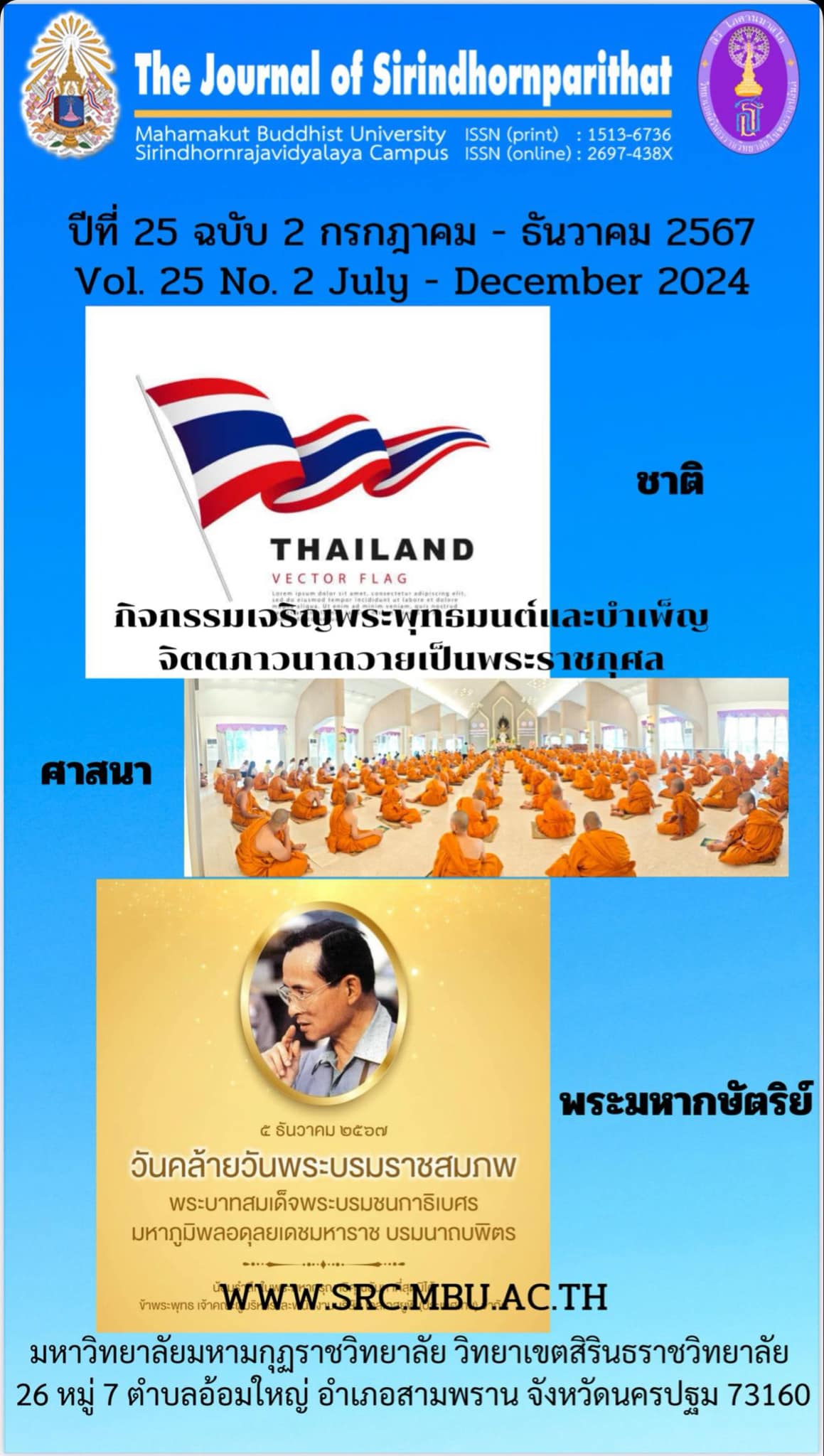Buddhology For Living With Other Faiths In The Pātika Sutta
Keywords:
BUDDHOLOGY, LIVING WITH OTHER FAITHS, THE PāTIKA SUTTAAbstract
This article has three objectives; 1) to study the state of coexistence of other religious people’s faiths in Tipitaka, 2) to study the Buddhist method of coexistence of other religious people’s faiths in Pāṭika-Sutta, and 3) to integrate the Buddhist method of peaceful coexistence of other religious people’s faiths in the present society. The qualitative research methodology focused on documentary research by studying the data from Tipitaka, Atthakatha, books, articles, dissertations, research works, and related electronic media. And field-works research was conducted by interviews with a group of students and qualified persons.
The result of the study of the state of coexistence of other religious people’s faiths in Tipitaka found that Buddhist society was influenced by the Indus Valley Civilization, which was divided into sixteen regions. Religious institutes were the origin of beliefs, devotion, and human behavior in society. It was an important institution to contribute to the customs, traditions, and manners of society. The social state of India in the Buddha’s period was considered there were many diversities of schools, and Brahmanism or Hinduism was the most influential religion.
The result of the study of the Buddhist method of coexistence of other religious people’s faiths in Pāṭika-Sutta found that there are three ways that the Lord Buddha used to attitude with other different religious people; 1) Sāmaggī-dhamma: harmony (Samānnachanda: mutual respect), the Lord Buddha never objected non-Buddhist monks but he always visited and exchanged ideas, because he realized that there are many diversities of schools which still exist in the society of India. He also was generous to the followers of other religions, which is one reason Buddhism is admired by those of other faiths. 2) Santi-dhamma: peace (compromise), Buddhism was born among the diversities of beliefs in society, after the enlightenment of the Lord Buddha, he proclaimed his teachings, changed adaptable teachings, and modified alternative ways to the people in the period. Especially, mutual respect was important, and the most important is “the establishment of ethics of coexistence”, which all can be accepted. 3) Respect for individual freedom, throughout the Buddha’s life, he never forced anyone to become his disciple. Their intellectual freedom was not forced to believe in Buddhism, whether it is to admit a person to become a monk or Buddhist, even a person who will recant to respect Buddhism, that is individual freedom without imposed any rules or regulations.
The result of the study of the Buddhist method of peaceful coexistence of other religious people’s faiths in the present society found that there consists of seven methods; 1) acceptance of other religious or doctrine ideas, 2) freedom of religious respect, 3) paying respect with the sympathy of hospitality, 4) communication with other religions by reality, 5) interaction in the case of conflict of beliefs, 6) point of parties and point of difference, and 7) the attitude for interaction and using appropriate method to the audience. These methods will contribute to the creation of a peaceful and harmonious society.
References
นิรันดร์ พันทรกิจ, “การสร้างความเข้าใจอันดีระหว่างศาสนา”. วารสารราชภัฏสุราษฎร์ธานี. ปีที่ 3 ฉบับที่ 1 (มกราคม – มิถุนายน, 2559) : 1-31.
พระเทพรัตนสุธี (สมศักดิ์ โชตินฺธโร). “กลยุทธ์การปกครองคณะสงฆ์ภาค 1”. ดุษฎีนิพนธ์พุทธศาสตรดุษฎีบัณฑิต. บัณฑิตวิทยาลัย: มหาวิทยาลัยมหาจุฬาลงกรณราชวิทยาลัย, 2557.
พระนิพ์พิชน์ โสภโณ, “พุทธวิธีในการปฏิบัติต่อบุคคลต่างศาสนา”, วารสาร มจร บาฬีศึกษาพุทธโฆสปริทรรศน์, ปีที่ 1 ฉบับที่ 2, (กรกฏาคม - ธันวาคม 2558).
พระมหานพดล ปุญฺญสุวฑฺฒโก ดร., “การอยู่ร่วมกันของคนในสังคมพหุวัฒนธรรม: กรณีศึกษาชุมชนเขตบางรัก กรุงเทพมหานคร “บทความวิจัยทุนสนับสนุนสถาบันวิจัยพุทธศาสตร์ มหาวิทยาลัยมหาจุฬาลงกรณราชวิทยาลัย, 2560, หน้า 1-23
พระมหาสุทิตย์ อาภากโร. “การอยู่ร่วมกันของประชาคมอาเซียน : แนวคิดและวิถีปฏิบัติตามแนวศาสนา”. รายงานวิจัย. พระนครศรีอยุธยา : สถาบันวิจัยพุทธศาสตร์ มหาวิทยาลัยมหาจุฬาลงกรณราชวิทยาลัย, 2557.
พระมหาหรรษา ธมฺมหาโส, พุทธสันติวิธี: การบูรณาการหลักการและเครื่องมือจัดการความขัดแย้ง, (กรุงเทพมหานคร: บริษัท 21 เซ็นจูรี่ จำกัด, 2554).
พระราชวัลภาจารย์ อาจารคุโณ, “ความสัมพันธ์ระหว่างพระพุทธศาสนากับนักบวชนอกศาสนา”วารสารนวัตกรรมการศึกษาและการวิจัย, ปีที่ 4 ฉบับที่ 1 (มกราคม – เมษายน 2020), หน้า 29-33.
พระราชวัลภาจารย์ อาจารคุโณ, “ความสัมพันธ์ระหว่างพระพุทธศาสนากับนักบวชนอกศาสนา”วารสารนวัตกรรมการศึกษาและการวิจัย, ปีที่ 4 ฉบับที่ 1 (มกราคม – เมษายน 2020), หน้า 29-33.
พระราชวัลภาจารย์, “ความสัมพันธ์ระหว่างพระพุทธศาสนากับนักบวชนอกศาสนา”, วารสารนวัตกรรมการศึกษาและการวิจัย, ปีที่ 4 ฉบับที่ 1 (มกราคม - เมษายน 2563) : หน้า 29.
สมิทธิพล เนตรนิมิต, มิติสังคมในพระสุตตันตปิฎก, (กรุงเทพมหานคร: สำนักพิมพ์ชีวาภิวัฒน์, 2550), หน้า 23.
Downloads
Published
Issue
Section
License
Copyright (c) 2024 Mahamakut Buddhist University

This work is licensed under a Creative Commons Attribution-NonCommercial-NoDerivatives 4.0 International License.
บทความที่ได้รับการตีพิมพ์เป็นลิขสิทธิ์ของ มหาวิทยาลัยมหามกุฏราชวิทยาลัย วิทยาเขตสิรินธรราชวิทยาลัย
ข้อความที่ปรากฏในบทความแต่ละเรื่องในวารสารวิชาการเล่มนี้เป็นความคิดเห็นส่วนตัวของผู้เขียนแต่ละท่านไม่เกี่ยวข้องกับหาวิทยาลัยมหามกุฏราชวิทยาลัย วิทยาเขตสิรินธรราชวิทยาลัย และคณาจารย์ท่านอื่นๆในมหาวิทยาลัยฯ แต่อย่างใด ความรับผิดชอบองค์ประกอบทั้งหมดของบทความแต่ละเรื่องเป็นของผู้เขียนแต่ละท่าน หากมีความผิดพลาดใดๆ ผู้เขียนแต่ละท่านจะรับผิดชอบบทความของตนเองแต่ผู้เดียว



